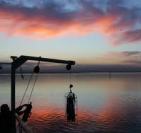The complaint alleges that the property values for homes owned by nine families have been reduced and the families' health has been jeopardized.

The Rockville, Md., facility supports the U.S. Navy's Strategic Systems Program.
The new climate module aims to make farmers more aware of the impacts of climate change and to promote the adoption of good agricultural practices that reduce greenhouse gas emissions, increase carbon sequestration and enhance the capacity of farms to adapt to climate change.
W.R. Grace & Co., and Tyco Healthcare Group, former site owners, will work with BIM Investment and Shaffer Realty Nominee Trust, current owners, to dredge soil, treat groundwater, and perform long-term monitoring.

Here's a glimpse of some preliminary results in the 2010 Environmental Protection Salary Survey.
- By L.K. Williams, EPonline
The study has implications for oxygen depletion, provides photographic evidence of plumes.
A study by researchers at the Jaume I University in Castellón shows that the legal minimum recycling requirement is only exceeded in the case of glass.

A memorandum of understanding outlines enhanced coordination of enforcement and compliance activities.
New Jersey has taken legal action against another out-of-state coal-fired power plant that is spewing pollutants into the air and impacting the state.
EPA is making the plans, which describe how companies are making their impoundments safer, available through its website.
EPA will host a conference on advancing the next generation of risk assessment in Washington, D.C.
According to the Texas Commission on Environmental Quality, more than 24 million pounds of computer equipment was collected in 2010.
The chemical manufacturers' group is seeking a three- to five-year reauthorization of the Chemical Facility Anti-Terrorism Standards.

This Valentine's Day, sweethearts can demonstrate their love for one another and for the environment by choosing gifts and activities that support the environment and improve the conditions of workers and communities around the world.

The federal agency and California want to improve water quality and resource protection in the San Francisco Bay Delta Estuary.
According to the food company, the system will provide 15 percent of the power needs of its Napoleon, Ohio plant.
Fueling up your car with ethanol produced from blue-green algae may sound far-fetched. But Bill Gibbons, a professor and researcher in SDSU’s Department of Biology and Microbiology, says it is close to reality – with commercial availability of this new generation of ethanol just four or five years away.
The Web-based tool should help government and industry personnel identify and prioritize cost-effective, sustainable strategies for small projects that do not normally engage workplace consultants or designers.
If society wants to address big picture environmental problems, like global climate change, acid rain, and coastal dead zones, we need to pay closer attention to the Earth's coupled biogeochemical cycles.
The $130 million facility will produce ethanol and renewable power from waste; this is a major first step in the company's global licensing strategy.